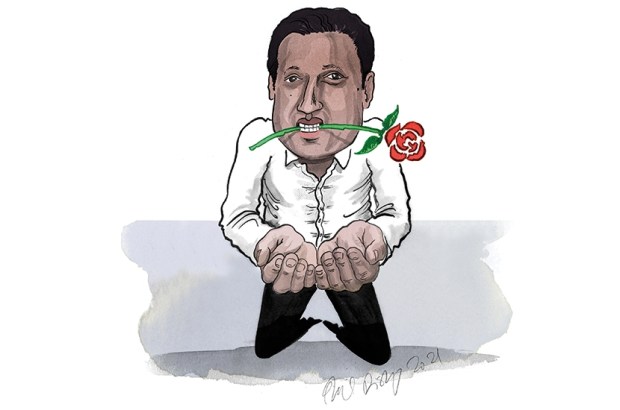Richmond Park is an eerie place at this time of year. It’s not just that it’s the deer rutting season, when huge stags fight over their harems, charging heavily about the misty grassland and bellowing as they go. It’s also the herds of photographers looming out of that mist, as strange as the prehistoric cries of the deer. Deer rutting is one of the most spectacular sights of autumn, and if you’re an amateur wildlife photographer like me, it’s hard to resist the attraction of rising early to photograph a 200kg monster roaring into the dawn.
I did just that last week, pedalling my way to the park in the morning gloaming, tripod on my back and a bag full of camera batteries. Shortly after I arrived, I heard my first stag. It was still too dark and the mist too thick to make out anything other than a collection of jaggedy shapes in the distance, so I crept closer over the soggy grass, and peered through my long lens. Sure enough, there was a tremendous beast, stalking around a collection of does, his antlers the size of a sapling. But not all the shapes were deer. Surrounding the animals was a second herd of men wearing camouflage and clutching long lenses.
These photographers were creeping closer and closer to the animals. I must have been about 80 metres away from the herd, and that felt close enough. These men — and they were all men — can’t have been more than 20 metres away. Some were even closer. I had come for the stags, but I ended up being fascinated by the way the need for the perfect photo meant these snappers were quite happy to put themselves in harm’s way: not only are stags heavy, they’re also fast and can move at 40 miles an hour. And in the rutting season, they’re so full of testosterone that they’ll attack anything that comes between them and their sex drive. A couple of years ago, a woman was gored by one.
Those interested in these things will recognise the behaviour of these men. It’s not limited to wildlife photographers, but also to a dedicated subset of naturalists known as ‘twitchers’. While some photographers will do anything to get the perfect shot, twitchers collect lists of the rare birds and animals that they’ve seen. Both will happily travel hundreds of miles, take risks to themselves and, more controversially, the animals around them.
It was presumably those foolhardy photographers who the Royal Parks had in mind when it warned visitors getting too close to the deer that they were threatening their own lives and also the wellbeing of the animals they had become obsessed with. Adam Curtis, who manages Richmond Park, said: ‘Once, I counted 60 photographers encircling a single stag. There are some very responsible wildlife photographers out there, but sadly there are far too many who value the photo over the subject.’
It’s not just during the Richmond rutting season that the behaviour of humans is almost more breathtaking than the animals they’re looking for. Turn up to see any natural spectacle, whether stags, rare birds or an unusual orchid, and you’ll find that among the crowd of admirers are people for whom an obsession has turned rather dark.
In a few cases, the warnings do get through, convincing some twitchers and photographers to change their habits. David Morris is a conservationist in northern England, and he gave up the practice of chasing after a new rare bird when he became tired of the behaviour of a minority of those around him. ‘There was a lightbulb moment; I saw some photographers pushing too close, the use of tape lures [when photographers play a tape of the call of the bird they are trying to see in order to flush it out of hiding] and flushing birds out of vegetation when they didn’t show sufficiently well. I came to the conclusion that personally I’d rather see birds in their home range, not as some wind-blown, knackered target.’
Joe Harkness has written a book, Bird Therapy, about how he uses birdwatching to help manage his obsessive compulsive disorder. He gave up local twitching when he realised it was actually making his mental health worse.
‘I went on this twitch where there was this bird that appeared in Norfolk,’ he says. ‘There were hundreds of people. It was horrific. They were encircling this bird. I leaned forward, saw it, and then this bloke asked me if I’d seen it. When I said yes, he physically picked me up and lifted me out of the way so he could see it.’
Even those who do enjoy a good twitch fret about some of the people they find themselves alongside. Sean Cole is a twitcher and orchid enthusiast, and once travelled from the Isle of Rum in Scotland to near Land’s End in order to see two different birds. He fell asleep on arrival in Land’s End and missed the hermit thrush he was on the hunt for, having had to wait a tense two hours to see it. ‘When I hear that there’s a bird around that I “need” [haven’t seen],’ he says, ‘I won’t rest until I see it. I just don’t feel right until I do, and if I decide not to try to get there and I hear that other people have seen the bird, that can haunt me for life.’
Nevertheless, Cole dislikes twitchers who become so obsessed with their subject that they are prepared to put animals in danger. He tells the story of a grey-cheeked thrush, freshly arrived on the Isles of Scilly from America, which ended up hopping further and further away from the crowd of over-zealous twitchers until eventually a large wave swept the exhausted creature into the sea and drowned it. He was also exasperated this summer when orchid-hunters ended up trampling over a collection of rare bright green fly orchids in Kent. But he does think that the destruction of habitats through ignorance of what’s living there is a far greater problem than a few clumsy obsessives.
I can’t mock twitchers: I’d arranged my own trip to photograph the Kentish orchids until they were destroyed. I’d like to think that I’m a little daintier on my feet, and that I wouldn’t break rules just to get the best photo. But I do know that urge, even though I don’t like it. It undermines the reason most people become naturalists: when you’re prepared to put yourself and the animal you’re after in danger, then it’s no longer about the wildlife, but about you.
Got something to add? Join the discussion and comment below.
Get 10 issues for just $10
Subscribe to The Spectator Australia today for the next 10 magazine issues, plus full online access, for just $10.
You might disagree with half of it, but you’ll enjoy reading all of it. Try your first month for free, then just $2 a week for the remainder of your first year.














Comments
Don't miss out
Join the conversation with other Spectator Australia readers. Subscribe to leave a comment.
SUBSCRIBEAlready a subscriber? Log in